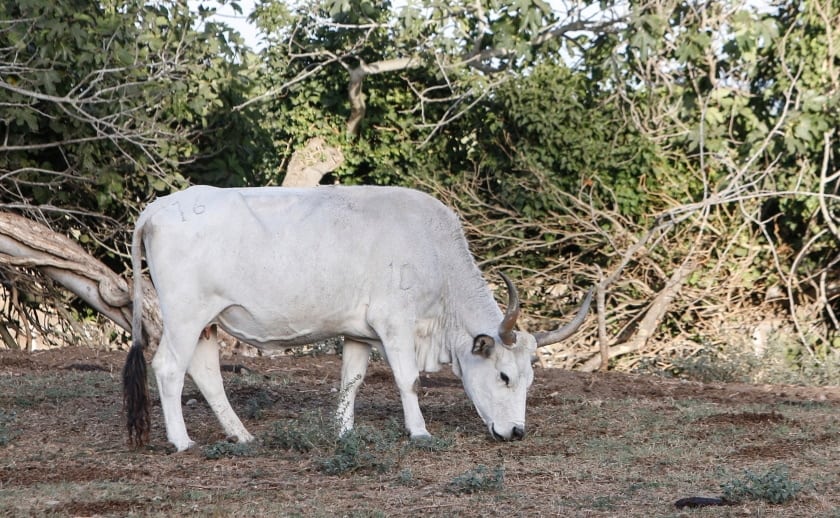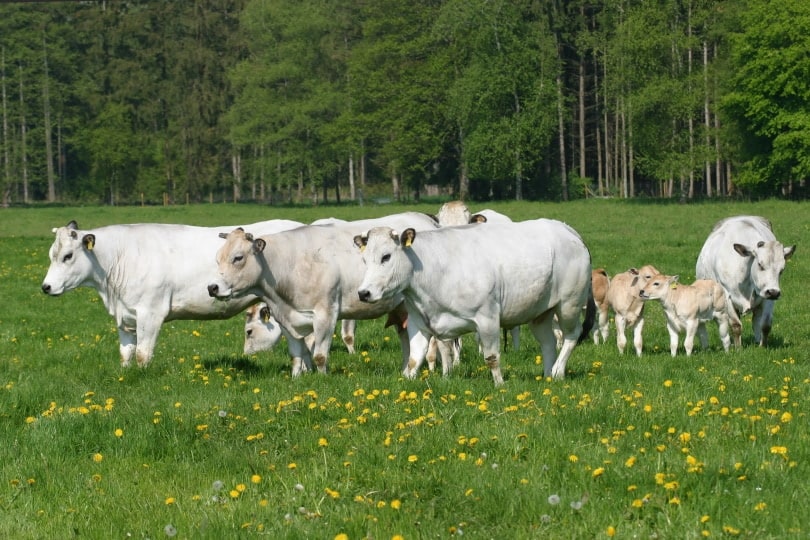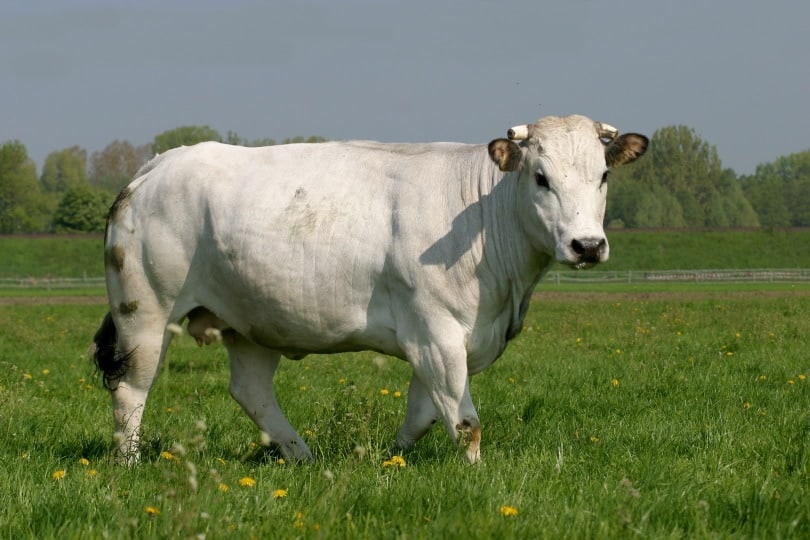The Chianina has seen many eras come and go, being one of the oldest cattle breeds in the world and dating back to the Roman Empire, around 2000 years ago. They’ve survived so well thanks to their robust and easily adaptable bodies. They don’t need much care and can manage in hot climates with sparse areas for grazing.
They’re not used for their milk as their supply is only enough for their offspring, but they have muscular, strong bodies that are widely used for meat and draught purposes. Keep reading for more information on this ancient cattle breed!

Quick Facts about the Chianina Cattle Breed

| Breed Name: | Chianina Cattle |
| Place of Origin: | Italy |
| Uses: | Dual-purpose |
| Bull (Male) Size: | 2,535–2,822 lbs |
| Cow (Female) Size: | 1,763–2,204 lbs |
| Color: | White and grey |
| Lifespan: | 20 years |
| Climate Tolerance: | They do well in warmer climates |
| Care Level: | Easy |
| Production: | Beef and draught purposes |
Chianina Cattle Origins
It’s often hard to give a definite answer to the origin of ancient breeds. However, we know the Chianina were used as work animals and often slaughtered for sacrifices during the Roman Empire. There are many Roman sculptures of this breed, along with a description from Columella, to back up their presence during this time.
Although it’s believed that the Chianina originates from Italy, there are theories that suggest they may have been brought into the area from Asia and Africa. Exportation of this breed started after the Second World War, and they’re now used for their meat in various parts of the world.

Chianina Cattle Characteristics
The Chianina is mainly used for meat production. Their meat is lean and of high quality. They’re late-maturing, very muscular, and have a higher dressing percentage than most other cattle. However, they have a poor milk yield and cannot be used for milk production.
Their meat isn’t the only characteristic that makes the breed favorable. They’re also easy to maintain and adapt well to just about any environment; however, the warmer the climate, the better. This makes them easy to export and breed in other countries. They don’t require high-quality grass and treatment to perform well. They’re very maternal, and they have a high likelihood of producing twins while having a low likelihood of experiencing calving difficulties. They also aren’t prone to suffering from genetic diseases.
This breed is not only heat-tolerant but has a strong resistance to parasites and disease, making their care easier. Farmers don’t have to lose sleep over worrying about this hardy cattle breed.
The Chianina is still sometimes used as a draft animal because of their strong muscles, endurance, and long legs. For thousands of years, they’ve worked with people and still display a nature that is submissive, able to take instruction, and not aggressive.

Uses
Chianina cattle are used for both labor and beef production. Due to new machinery that has taken on the task that this cattle breed used to perform, they’re not needed as much for draught purposes and are quickly solely becoming popular for their meat. However, they’re still used in production in less developed countries where it’s cheaper to maintain cattle than it is to purchase and work machinery.
Chianina beef is loved and eaten all over the world, with the Chianina being the meat of the famous bistecca alla Fiorentina. It’s especially appreciated for its lean and high-quality properties and tends to be a bit more expensive.
Appearance & Varieties
This breed of cattle is one of the largest—and heaviest—in the world, with a height over 6 feet and a weight of over 2,500 pounds. Not only are they tall, but also long. You’ll be able to spot a Chianina from a distance due to their great size and attractive white or grey coat color, which is smooth and short.
They have black tails, noses, tongues, and eye areas that are protected from the harsh sun. They have short horns that curve and darken at the tip. Their heads are long, just like their legs. They have well-defined muscles on their shoulders, thighs, and rump, along with strong hooves, but they have relatively small udders and look slender.
Bulls can have darker shadings than cows, and calves start their life as light brown, turning lighter and lighter the older they become.

Population/Distribution
Although the Chianina originated from Italy, it has found itself all over the world and has adapted well. The first Chianina calf (that was mixed with Angus) was born in the USA in 1971 after an American soldier encountered the breed and shipped its semen back to his country. The semen from Chianina cattle have been combined with other cattle to produce the desired features for beef production.
Since the breed caught the attention of the soldiers and other people from outside of Italy after the Second World War, the Chianina has become quite popular and can be found in the US, Australia, Canada, Africa, and China. However, the largest population still remains in Italy.

Are Chianina Cattle Good for Small-Scale Farming?
Due to the level of maintenance required and the nature of the Chianina cattle breed, they are good for both small and large-scale farming. They aren’t a difficult breed to maintain, can survive on a variety of grass, from lush to dry, are parasite-resistant, perform well in most climates, especially warm ones, and are hardy. They’ve been bred to work and perform well with people, displaying a submissive and easy nature. They are maternal and tend to have easy births with calves that rarely have genetic problems. They are an excellent breed to be raised for beef and used for farm labor.
The Chianina is an ancient cattle breed that has stood the test of time because of their hardy bodies that are heat and parasite-resistant. They’re an excellent choice for beef production and farm labor as their bodies are bred for it. They originated in Italy but have been exported through semen all around the world.
See Also:
Featured Image Credit: R. Maximiliane, Shutterstock
